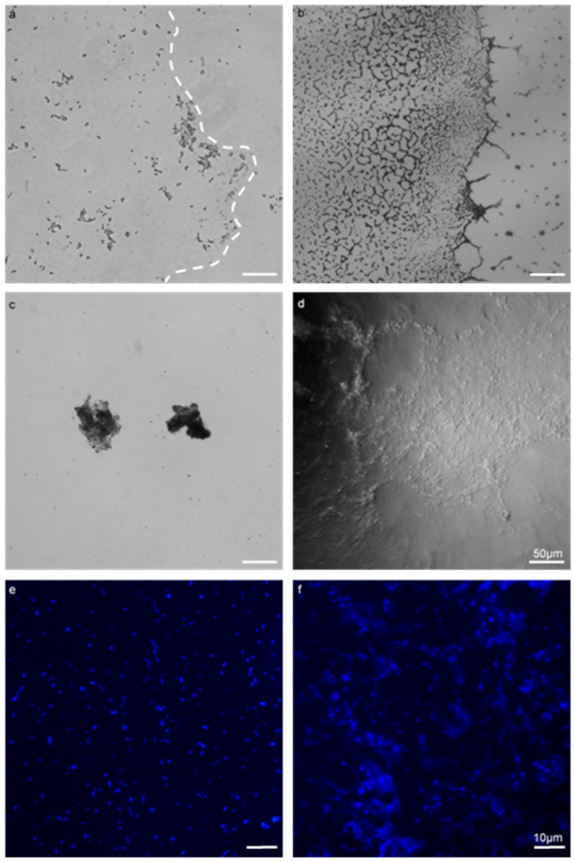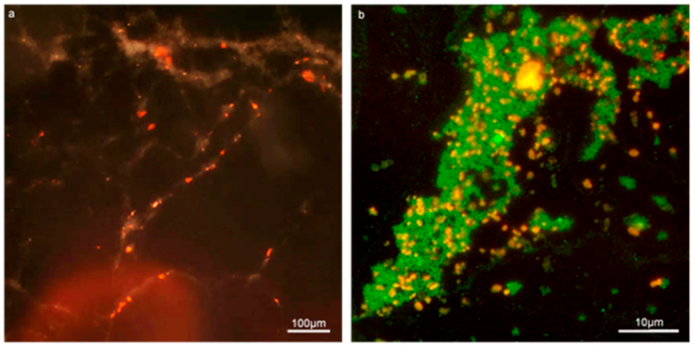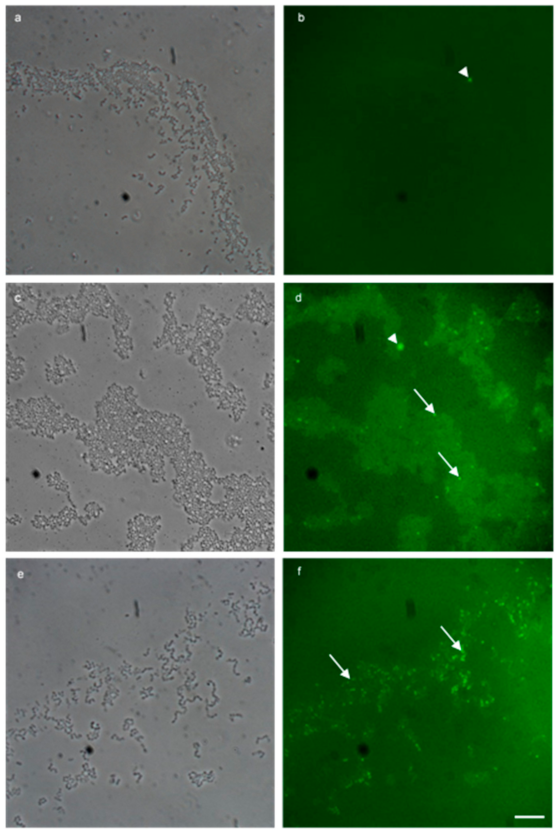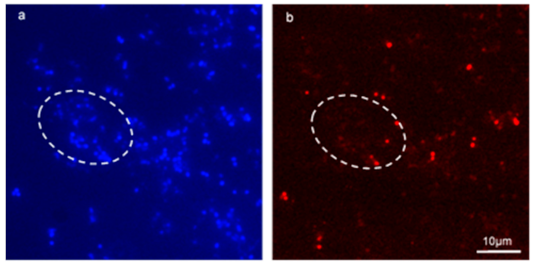A Novel Biofilm Model System to Visualise Conjugal Transfer of Vancomycin Resistance by Environmental Enterococci
Abstract
:1. Introduction
2. Materials and Methods
2.1. Bacterial Strains and Fluorescent In Situ Hybridisation (FISH) Probes
2.2. Culture Conditions for Growth of Enterococcal Biofilm
2.3. Characterisation of the GFA Grown Biofilm
2.4. Quantification of Cell Biomass
2.5. Fluorescent Imaging of Enterococci in Biofilm
2.6. Detection of Conjugation in Biofilm using the Gene Frame®
2.7. Fluorescent In Situ Hybridisation (FISH) Detection of Enterococcal Cells and vanA Antibiotic Resistance Gene in Biofilm
2.8. Visualisation of Enterococcal Transconjugants in a Conjugal Biofilm
2.9. Statistical Analysis
3. Results and Discussion
3.1. Growth of Biofilm in GFA
3.2. Characterisation of Biofilm Using Con-A Staining of EPS
3.3. Detection of vanA in Biofilm Using Multi-Probe FISH
3.4. Detection of vanA Transconjugants in Biofilm
3.5. Visualising HGT between Species
3.6. Application of Gene Frame Apparatus Model to Biofilm Studies
3.7. Deployment of Con-A to Identify EPS in Biofilm
3.8. FISH Visualisation of vanA Transconjugants
3.9. In Situ Detection of Transconjugants
4. Conclusions
Supplementary Materials
Author Contributions
Funding
Institutional Review Board Statement
Informed Consent Statement
Data Availability Statement
Acknowledgments
Conflicts of Interest
References
- Ahmed, M.O.; Baptiste, K.E. Vancomycin-Resistant Enterococci: A Review of Antimicrobial Resistance Mechanisms and Perspectives of Human and Animal Health. Microb. Drug Resist. 2018, 24, 590–606. [Google Scholar] [CrossRef] [PubMed] [Green Version]
- WHO. Global Priority List of Antibiotic-Resistant Bacteria to Guide Research, Discovery, and Development of New Antibiotics. Available online: https://www.who.int/medicines/publications/WHO-PPL-Short_Summary_25Feb-ET_NM_WHO.pdf (accessed on 30 October 2019).
- ECDC. Surveillance of Antimicrobial Resistance in Europe 2018–2019. Available online: https://www.ecdc.europa.eu/en/publications-data/surveillance-antimicrobial-resistance-europe-2018 (accessed on 5 February 2021).
- Juma, A.; Lemoine, P.; Simpson, A.B.J.; Murray, J.; O’Hagan, B.M.G.; Naughton, P.J.; Dooley, J.G.; Banat, I.M. Microscopic Investigation of the Combined Use of Antibiotics and Biosurfactants on Methicillin Resistant Staphylococcus aureus. Front. Microbiol 2020, 7, 1477. [Google Scholar] [CrossRef] [PubMed]
- Hung, W.-W.; Chen, Y.-H.; Tseng, S.-P.; Jao, Y.-T.; Teng, L.-J.; Hung, W.-C. Using GroEL as the Target for Identification of Enterococcus Faecium Clades and 7 Clinically Relevant Enterococcus Species. J. Microbiol. Immunol. Infect. 2019, 52, 255–264. [Google Scholar] [CrossRef] [PubMed]
- Uçkay, I.; Pires, D.; Agostinho, A.; Guanziroli, N.; Öztürk, M.; Bartolone, P.; Tscholl, P.; Betz, M.; Pittet, D. Enterococci in Orthopaedic Infections: Who Is at Risk Getting Infected? J. Infect. 2017, 75, 309–314. [Google Scholar] [CrossRef] [Green Version]
- Kreidl, P.; Mayr, A.; Hinterberger, G.; Berktold, M.; Knabl, L.; Fuchs, S.; Posch, W.; Eschertzhuber, S.; Obwegeser, A.; Lass-Flörl, C. Outbreak Report: A Nosocomial Outbreak of Vancomycin Resistant Enterococci in a Solid Organ Transplant Unit. Antimicrob. Resist. Infect. Control. 2018, 7. [Google Scholar] [CrossRef]
- Gilmore, B. Editorial (Thematic Issue:Emerging Concepts in Bacterial Biofilm Control). CPD 2014, 21, 3–4. [Google Scholar] [CrossRef]
- Tan, C.A.Z.; Antypas, H.; Kline, K.A. Overcoming the challenge of establishing biofilms in vivo: A roadmap for Enterococci. Curr. Opin. Microbiol. 2020, 53, 9–18. [Google Scholar] [CrossRef]
- Azeredo, J.; Azevedo, N.F.; Briandet, R.; Cerca, N.; Coenye, T.; Costa, A.R.; Desvaux, M.; Di Bonaventura, G.; Hébraud, M.; Jaglic, Z.; et al. Critical review on biofilm methods. Crit. Rev. Microbiol. 2017, 43, 313–351. [Google Scholar] [CrossRef] [Green Version]
- McLean, J.S.; Wanger, G.; Gorby, Y.A.; Wainstein, M.; McQuaid, J.; Ishii, S.I.; Bretschger, O.; Beyenal, H.; Nealson, K.H. Quantification of Electron Transfer Rates to a Solid Phase Electron Acceptor through the Stages of Biofilm Formation from Single Cells to Multicellular Communities. Environ. Sci. Technol. 2010, 44, 2721–2727. [Google Scholar] [CrossRef]
- Kostakioti, M.; Hadjifrangiskou, M.; Hultgren, S.J. Bacterial Biofilms: Development, Dispersal, and Therapeutic Strategies in the Dawn of the Postantibiotic Era. Cold Spring Harb. Perspect. Med. 2013, 3, a010306. [Google Scholar] [CrossRef] [Green Version]
- Rickard, A.H.; Gilbert, P.; High, N.J.; Kolenbrander, P.E.; Handley, P.S. Bacterial Coaggregation: An Integral Process in the Development of Multi-Species Biofilms. Trends Microbiol. 2003, 11, 94–100. [Google Scholar] [CrossRef]
- Monds, R.D.; O’Toole, G.A. The Developmental Model of Microbial Biofilms: Ten Years of a Paradigm up for Review. Trends Microbiol. 2009, 17, 73–87. [Google Scholar] [CrossRef]
- McDougald, D.; Rice, S.A.; Barraud, N.; Steinberg, P.D.; Kjelleberg, S. Should We Stay or Should We Go: Mechanisms and Ecological Consequences for Biofilm Dispersal. Nat. Rev. Microbiol. 2012, 10, 39–50. [Google Scholar] [CrossRef]
- Sterling, A.J.; Snelling, W.J.; Naughton, P.J.; Ternan, N.G.; Dooley, J.S.G. Competent but complex communication: The phenomena of pheromone-responsive plasmids. PLoS Pathog. 2020, 16, e1008310. [Google Scholar] [CrossRef]
- Weng, P.L.; Ramli, R.; and Hamat, R.A. Antibiotic susceptibility patterns, biofilm formation and esp gene among clinical enterococci: Is there any association? Int J. Environ. Res. Public Health 2019, 16, 3439. [Google Scholar] [CrossRef] [Green Version]
- Cook, L.; Chatterjee, A.; Barnes, A.; Yarwood, J.; Hu, W.-S.; Dunny, G. Biofilm growth alters regulation of conjugation by a bacterial pheromone. Mol. Microbiol. 2011, 81, 1499–1510. [Google Scholar] [CrossRef] [Green Version]
- Breuer, R.J.; Hirt, H.; Dunny, G.M. Mechanistic Features of the Enterococcal PCF10 Sex Pheromone Response and the Biology of Enterococcus Faecalisin Its Natural Habitat. J. Bacteriol. 2018, 200, e00733-17. [Google Scholar] [CrossRef] [Green Version]
- Fux, C.A.; Stoodley, P.; Hall-Stoodley, L.; Costerton, J.W. Bacterial biofilms: A diagnostic and therapeutic challenge. Expert Rev. Anti Infect. Ther. 2003, 1, 667–683. [Google Scholar] [CrossRef]
- Balcázar, J.L.; Subirats, J.; Borrego, C.M. The role of biofilms as environmental reservoirs of antibiotic resistance. Front. Microbiol. 2015, 6, 1216. [Google Scholar] [CrossRef] [Green Version]
- Conwell, M.; Daniels, V.; Naughton, P.J.; Dooley, J.S.G. Interspecies Transfer of Vancomycin, Erythromycin and Tetracycline Resistance among Enterococcus Species Recovered from Agrarian Sources. BMC Microbiol. 2017, 17. [Google Scholar] [CrossRef] [Green Version]
- Cartwright, A.; Arnscheidt, J.; Conwell, M.; Dooley, J.S.G.; McGonigle, C.; Naughton, P.J. Effects of freshwater sponge Ephydatia fluviatilis on conjugative transfer of antimicrobial resistance in Enterococcus faecalis strains in aquatic environments. Lett. Appl. Microbiol. 2020, 71, 39–45. [Google Scholar] [CrossRef]
- Wellinghausen, N.; Bartel, M.; Essig, A.; Poppert, S. Rapid Identification of Clinically Relevant Enterococcus Species by Fluorescence In Situ Hybridization. J. Clin. Microbiol. 2007, 45, 3424–3426. [Google Scholar] [CrossRef] [Green Version]
- Ballard, S.A.; Grabsch, E.A.; Johnson, P.D.; Grayson, M.L. Comparison of three PCR primer sets for identification of vanB gene carriage in feces and correlation with carriage of vancomycin-resistant enterococci: Interference by vanB-containing anaerobic bacilli. Antimicrob. Agents Chemother. 2005, 49, 77–81. [Google Scholar] [CrossRef] [Green Version]
- Gurtler, V.; Grando, D.; Mayall, B.C.; Wang, J.; Ghaly-Derias, S. A novel method for simultaneous Enterococcus species identification/typing and van genotyping by high resolution melt analysis. J. Microbiol. Methods 2012, 90, 167–181. [Google Scholar] [CrossRef]
- Stothard, P. The Sequence Manipulation Suite: JavaScript Programs for Analyzing and Formatting Protein and DNA Sequences. BioTechniques 2000, 28, 1102–1104. [Google Scholar] [CrossRef] [Green Version]
- Pernthaler, A.; Preston, C.M.; Pernthaler, J.; DeLong, E.F.; Amann, R. Comparison of fluorescently labeled oligonucleotide and polynucleotide probes for the detection of pelagic marine bacteria and archaea. Appl. Environ. Microbiol. 2002, 68, 661–667. [Google Scholar] [CrossRef] [Green Version]
- Conwell, M. Transfer of Antibiotic Resistances between Enterococci in Biofilm. Ph.D. Thesis, University of Ulster, Ulster, UK, 2018. [Google Scholar]
- Thompson, K.A.; McArthur, J.C.; and Wesselingh, S.L. Correlation between neurological progression and astrocyte apoptosis in HIV-associated dementia. Annals of Neurology: Off. J. Am. Neurol. Assoc. Child. Neurol. Soc. 2001, 49, 745–752. [Google Scholar] [CrossRef]
- Hussein, E.A.; Hair-Bejo, M.; Omar, A.R.; Arshad, S.S.; Hani, H.; Balakrishnan, K.N.; Yakubu, Y.; Saeed, M.I.; Aini, I. Velogenic newcastle disease virus tissue tropism and pathogenesis of infection in chickens by application of in situ PCR, immunoperoxase staining and HE staining. Microb. Pathog. 2019, 129, 213–223. [Google Scholar] [CrossRef]
- Lossi, L.; Gambino, G.; Salio, C.; Merighi, A. Direct in situ RT-PCR. In Neuropeptides; Humana Press: Totowa, NJ, USA, 2011; pp. 111–126. [Google Scholar]
- Waar, K. Fluorescent in Situ Hybridization with Specific DNA Probes Offers Adequate Detection of Enterococcus Faecalis and Enterococcus Faecium in Clinical Samples. J. Med. Microbiol. 2005, 54, 937–944. [Google Scholar] [CrossRef]
- Kishen, A.; Haapasalo, M. Endodontic Biofilm: Where Are We Now and Where Are We Going? Endod Top. 2010, 22, 1. [Google Scholar] [CrossRef]
- Fisher, K.; Phillips, C. The Ecology, Epidemiology and Virulence of Enterococcus. Microbiology 2009, 155, 1749–1757. [Google Scholar] [CrossRef] [PubMed] [Green Version]
- Ch’ng, J.-H.; Chong, K.K.L.; Lam, L.N.; Wong, J.J.; Kline, K.A. Biofilm-Associated Infection by Enterococci. Nat. Rev. Microbiol. 2019, 17, 82–94. [Google Scholar] [CrossRef] [PubMed]
- Ch’ng, J.H.; Chong, K.K.L.; Lam, L.N.; Wong, J.J.; Kline, K.A. Author Correction: Biofilm-associated infection by enterococci. Nat. Rev. Microbiol. 2019, 17, 124. [Google Scholar] [CrossRef] [PubMed]
- Garrett, T.R.; Bhakoo, M.; Zhang, Z. Bacterial Adhesion and Biofilms on Surfaces. Prog. Nat. Sci. 2008, 18, 1049–1056. [Google Scholar] [CrossRef]
- Nguyen, D.; Joshi-Datar, A.; Lepine, F.; Bauerle, E.; Olakanmi, O.; Beer, K.; McKay, G.; Siehnel, R.; Schafhauser, J.; Wang, Y. Active Starvation Responses Mediate Antibiotic Tolerance in Biofilms and Nutrient-Limited Bacteria. Science 2011, 334, 982–986. [Google Scholar] [CrossRef] [Green Version]
- Stewart, E.J.; Ganesan, M.; Younger, J.G.; Solomon, M.J. Artificial Biofilms Establish the Role of Matrix Interactions in Staphylococcal Biofilm Assembly and Disassembly. Sci. Rep. 2015, 5. [Google Scholar] [CrossRef] [Green Version]
- Dale, J.L.; Nilson, J.L.; Barnes, A.M.T.; Dunny, G.M. Restructuring of Enterococcus faecalis biofilm architecture in response to antibiotic-induced stress. NJP Biofilms Microbiomes 2017, 3, 15. [Google Scholar] [CrossRef] [Green Version]
- Leuck, A.-M.; Johnson, J.R.; Dunny, G.M. A Widely Used In Vitro Biofilm Assay Has Questionable Clinical Significance for Enterococcal Endocarditis. PLoS ONE 2014, 9, e107282. [Google Scholar] [CrossRef]
- Dunny, G.; Hancock, L.; Shankar, N. Enterococcal Biofilm Structure and Role in Colonization and Disease. In Enterococci: From Commensals to Leading Causes of Drug Resistant Infection [Internet]; Gilmore, M., Clewell, D., Ike, Y., Shankar, N., Eds.; Massachusetts Eye and Ear Infirmary: Boston, MA, USA, 2014. [Google Scholar]
- Guiton, P.S.; Hung, C.S.; Kline, K.A.; Roth, R.; Kau, A.L.; Hayes, E.; Heuser, J.; Dodson, K.W.; Caparon, M.G.; Hultgren, S.J. Contribution of Autolysin and Sortase A during Enterococcus Faecalis DNA-Dependent Biofilm Development. Infect. Immun. 2009, 77, 3626–3638. [Google Scholar] [CrossRef] [Green Version]
- Kishen, A.; Haapasalo, M. Biofilm Models and Methods of Biofilm Assessment. Endod. Top. 2010, 22, 58–78. [Google Scholar] [CrossRef]
- McSwain, B.S.; Irvine, R.L.; Hausner, M.; Wilderer, P.A. Composition and Distribution of Extracellular Polymeric Substances in Aerobic Flocs and Granular Sludge. Appl. Environ. Microbiol. 2005, 71, 1051–1057. [Google Scholar] [CrossRef] [Green Version]
- Hogendorf, W.F.J.; den Bos, L.J.V.; Overkleeft, H.S.; Codée, J.D.C.; der Marel, G.A.V. Synthesis of an α-Kojibiosyl Substituted Glycerol Teichoic Acid Hexamer. Bioorganic Med. Chem. 2010, 18, 3668–3678. [Google Scholar] [CrossRef]
- Jung, Y.-G.; Choi, J.; Kim, S.-K.; Lee, J.-H.; Kwon, S. Embedded Biofilm, a New Biofilm Model Based on the Embedded Growth of Bacteria. Appl. Environ. Microbiol. 2015, 81, 211–219. [Google Scholar] [CrossRef] [Green Version]
- Ridan, C.; Benxiang, H. Development of an Enterococcus faecalis periapical biofilm model for in vitro morphological study. W China J. Stomatol. 2014, 32. [Google Scholar] [CrossRef]
- Zhang, T.; Muraih, J.K.; MacCormick, B.; Silverman, J.; Palmer, M. Daptomycin Forms Cation- and Size-Selective Pores in Model Membranes. Biochim. Biophys. Acta (BBA) Biomembr. 2014, 1838, 2425–2430. [Google Scholar] [CrossRef] [Green Version]
- Funston, S.J.; Tsaousi, K.; Rudden, M.; Smyth, T.J.; Stevenson, P.S.; Marchant, R.; Banat, I.M. Characterising Rhamnolipid Production in Burkholderia Thailandensis E264, a Non-Pathogenic Producer. Appl. Microbiol. Biotechnol. 2016, 100, 7945–7956. [Google Scholar] [CrossRef] [Green Version]
- Tabenski, L.; Maisch, T.; Santarelli, F.; Hiller, K.A.; Schmalz, G. Individual growth detection of bacterial species in an in vitro polymicrobial biofilm model. Arch Microbiol 2014, 196, 819–828. [Google Scholar] [CrossRef]
- Oliveira, D.C.; Tomasz, A.; de Lencastre, H. Secrets of Success of a Human Pathogen: Molecular Evolution of Pandemic Clones of Meticillin-Resistant Staphylococcus Aureus. Lancet Infect. Dis. 2002, 2, 180–189. [Google Scholar] [CrossRef]
- Harmsen, H.J.M.; Elfferich, P.; Schut, F.; Welling, G.W. A 16S RRNA-Targeted Probe for Detection of Lactobacilli and Enterococci in Faecal Samples by FluorescentIn SituHybridization. Microb. Ecol. Health Dis. 1999, 11. [Google Scholar] [CrossRef]
- Roller, C.; Wagner, M.; Amann, R.; Ludwig, W.; Schleifer, K.-H. In Situ Probing of Gram-Positive Bacteria with High DNA G + C Content Using 23S RRNA-Targeted Oligonucleotides. Microbiology 1994, 140, 2849–2858. [Google Scholar] [CrossRef] [Green Version]
- Zwirglmaier, K.; Ludwig, W.; Schleifer, K.-H. Recognition of Individual Genes in a Single Bacterial Cell by Fluorescence in Situ Hybridization—RING-FISH. Mol. Microbiol. 2003, 51, 89–96. [Google Scholar] [CrossRef] [PubMed] [Green Version]
- Hufnagel, M.; Koch, S.; Creti, R.; Baldassarri, L.; Huebner, J. A Putative Sugar-Binding Transcriptional Regulator in a Novel Gene Locus in Enterococcus Faecalis Contributes to Production of Biofilm and Prolonged Bacteraemia in Mice. J. Infect. Dis. 2004, 189, 420–430. [Google Scholar] [CrossRef] [Green Version]
- Kristich, C.J.; Li, Y.-H.; Cvitkovitch, D.G.; Dunny, G.M. Esp-Independent Biofilm Formation by Enterococcus Faecalis. J. Bacteriol. 2004, 186, 154–163. [Google Scholar] [CrossRef] [Green Version]
- Rosa, R.; Creti, R.; Venditti, M.; D’Amelio, R.; Arciola, C.R.; Montanaro, L.; Baldassarri, L. Relationship between Biofilm Formation, the Enterococcal Surface Protein (Esp) and Gelatinase in Clinical Isolates of Enterococcus Faecalis and Enterococcus Faecium. FEMS Microbiol. Lett. 2006, 256, 145–150. [Google Scholar] [CrossRef] [Green Version]
- Creti, R.; Koch, S.; Fabretti, F.; Baldassarri, L.; Huebner, J. Enterococcal Colonization of the Gastro-Intestinal Tract: Role of Biofilm and Environmental Oligosaccharides. BMC Microbiol. 2006, 6, 60. [Google Scholar] [CrossRef] [Green Version]
- Zaborowska, M.; Tillander, J.; Brånemark, R.; Hagberg, L.; Thomsen, P.; Trobos, M. Biofilm Formation and Antimicrobial Susceptibility of Staphylococci and Enterococci from Osteomyelitis Associated with Percutaneous Orthopaedic Implants. J. Biomed. Mater. Res. 2017, 105, 2630–2640. [Google Scholar] [CrossRef]
- Balzer, M.; Witt, N.; Flemming, H.C.; Wingender, J. Faecal indicator bacteria in river biofilms. Water Sci. Technol. 2010, 61, 1105–1111. [Google Scholar] [CrossRef]
- Sillanpää, J.; Nallapareddy, S.R.; Singh, K.V.; Prakash, V.P.; Fothergill, T.; Ton-That, H.; Murray, B.E. Characterization of the ebpfm pilus-encoding operon of Enterococcus faecium and its role in biofilm formation and virulence in a murine model of urinary tract infection. Virulence 2010, 1, 236–246. [Google Scholar] [CrossRef] [Green Version]
- Barnes, A.M.; Dale, J.L.; Chen, Y.; Manias, D.A.; Greenwood Quaintance, K.E.; Karau, M.K.; Kashyap, P.C.; Patel, R.; Wells, C.L.; Dunny, G.M. Enterococcus faecalis readily colonizes the entire gastrointestinal tract and forms biofilms in a germ-free mouse model. Virulence 2017, 8, 282–296. [Google Scholar] [CrossRef] [Green Version]
- Willett, J.L.; Ji, M.M.; Dunny, G.M. Exploiting biofilm phenotypes for functional characterization of hypothetical genes in Enterococcus faecalis. NPJ Biofilms Microbiomes 2019, 5, 1–14. [Google Scholar] [CrossRef]
- Archambaud, C.; Derré-Bobillot, A.; Lapaque, N.; Rigottier-Gois, L.; and Serror, P. Intestinal translocation of enterococci requires a threshold level of enterococcal overgrowth in the lumen. Sci. Rep. 2019, 9, 8926. [Google Scholar] [CrossRef] [PubMed] [Green Version]
- Lépesová, K.; Kraková, L.; Pangallo, D.; Medveďová, A.; Olejníková, P.; Mackuľak, T.; Tichý, J.; Grabic, R.; Birošová, L. Prevalence of antibiotic-resistant coliform bacteria, Enterococcus spp. and Staphylococcus spp. in wastewater sewerage biofilm. J. Glob. Antimicrob. Res. 2018, 14, 145–151. [Google Scholar] [CrossRef] [PubMed]
- Hamiwe, T.; Kock, M.M.; Magwira, C.A.; Antiabong, J.F.; Ehlers, M.M. Occurrence of enterococci harbouring clinically important antibiotic resistance genes in the aquatic environment in Gauteng, South Africa. Environ. Poll. 2019, 245, 1041–1049. [Google Scholar] [CrossRef]
- Li, X.D.; Chen, Y.H.; Liu, C.; Hong, J.; Deng, H.; Yu, D.J. Eutrophication and Related Antibiotic Resistance of Enterococci in the Minjiang River, China. Microb. Ecol. 2019, 1–13. [Google Scholar] [CrossRef]
- Benoit, M.R.; Conant, C.G.; Ionescu-Zanetti, C.; Schwartz, M.; Matin, A. New device for high-throughput viability screening of flow biofilms. Appl. Environ. Microbiol. 2010, 76, 4136–4142. [Google Scholar] [CrossRef] [Green Version]
- Blaze, M.M.; Aydin, B.; Carlson, R.; Hanley, L. Identification and imaging of peptides and proteins on Enterococcus faecalis biofilms by matrix assisted laser desorption ionization mass spectrometry. Analyst 2012, 137, 5018. [Google Scholar] [CrossRef] [Green Version]
- Porayath, C.; Suresh, M.K.; Biswas, R.; Nair, B.G.; Mishra, N.; Pal, S. Autolysin mediated adherence of Staphylococcus aureus with fibronectin, gelatin and heparin. Int. J. Biol. Macromol. 2018, 110, 179–184. [Google Scholar] [CrossRef]
- Fernandes, M.D.S.; de Oliveira, A.M.; Cheriegate, A.P.C.; de Abreu Filho, B.A. Bacteria isolated from the bovine gelatin production line: Biofilm formation and use of different sanitation procedures to eliminate the biofilms. J. Food Saf. 2018, 38, e12489. [Google Scholar] [CrossRef]






| Isolate | Species | Resistance | Biofilm Production | Conjugation Role | Reference |
|---|---|---|---|---|---|
| MF06036 | E. faecalis | Van, Ery, Tet | Moderate | Donor | [22] |
| MW01105Rif | E. faecalis | Rif | Moderate | Recipient | [22] |
| ST01109Rif | E. faecium | Rif | Moderate | Recipient | [22] |
| MF04010 | E. faecalis | Tet, Gen | Moderate | Donor | [29] |
| Target | Probe | Sequence 5′ to 3′ | Reference |
|---|---|---|---|
| Enterococcus vanA | vanA 1 | GCAAGTCAGGTGAAGATGGA | This study |
| vanA 2 | AGGAGCATGACGTATCGGTA | This study | |
| E. faecalis 16S rRNA | ENF 191 | GAAAGCGCCTTTCACTCTTATGC | [24] |
| E. faecium 23S rRNA | ENU 1470 | GACTCCTTCAGACTTACTGCTTGG | [24] |
Publisher’s Note: MDPI stays neutral with regard to jurisdictional claims in published maps and institutional affiliations. |
© 2021 by the authors. Licensee MDPI, Basel, Switzerland. This article is an open access article distributed under the terms and conditions of the Creative Commons Attribution (CC BY) license (https://creativecommons.org/licenses/by/4.0/).
Share and Cite
Conwell, M.; Dooley, J.S.G.; Naughton, P.J. A Novel Biofilm Model System to Visualise Conjugal Transfer of Vancomycin Resistance by Environmental Enterococci. Microorganisms 2021, 9, 789. https://doi.org/10.3390/microorganisms9040789
Conwell M, Dooley JSG, Naughton PJ. A Novel Biofilm Model System to Visualise Conjugal Transfer of Vancomycin Resistance by Environmental Enterococci. Microorganisms. 2021; 9(4):789. https://doi.org/10.3390/microorganisms9040789
Chicago/Turabian StyleConwell, Michael, James S. G. Dooley, and Patrick J. Naughton. 2021. "A Novel Biofilm Model System to Visualise Conjugal Transfer of Vancomycin Resistance by Environmental Enterococci" Microorganisms 9, no. 4: 789. https://doi.org/10.3390/microorganisms9040789






